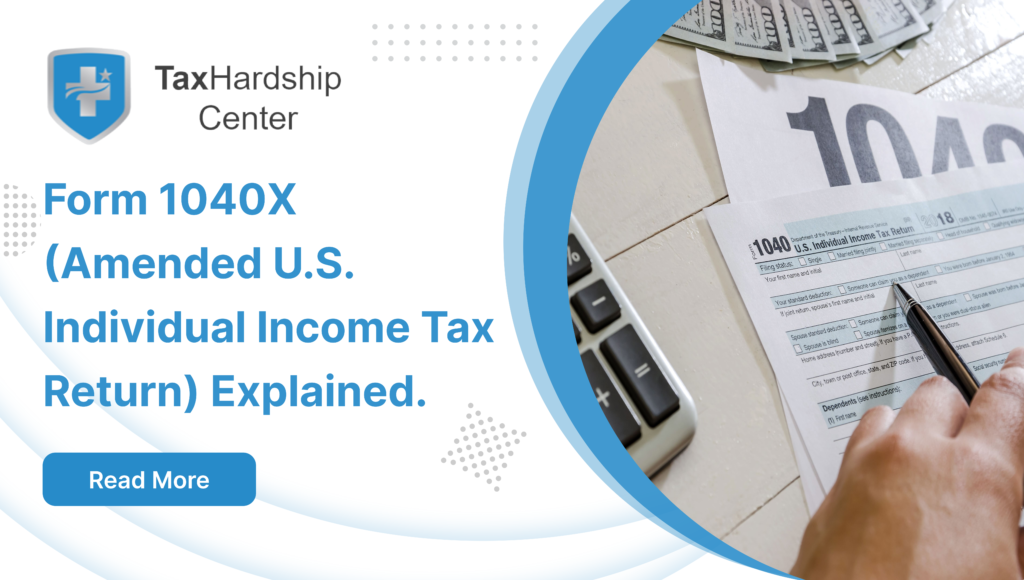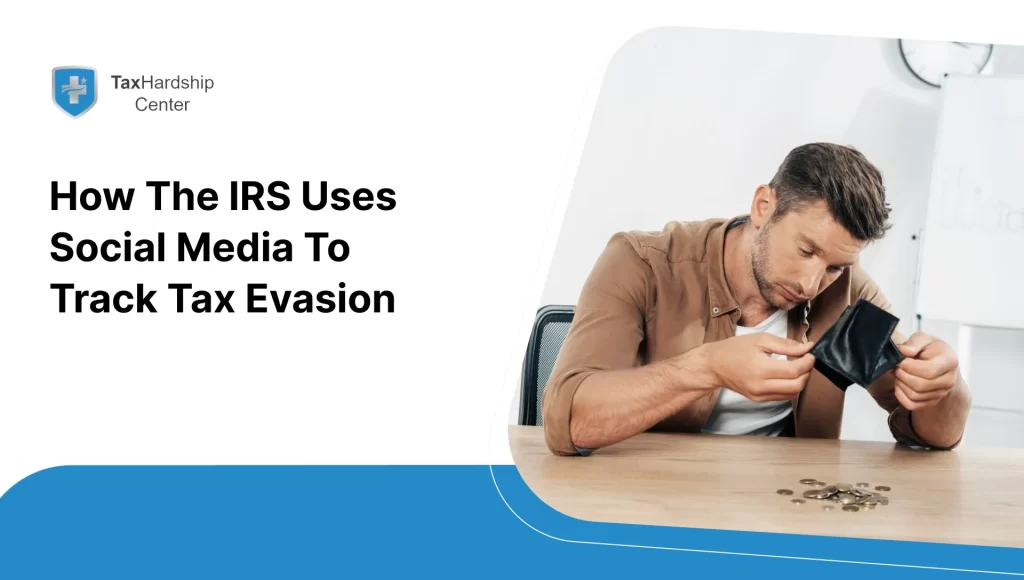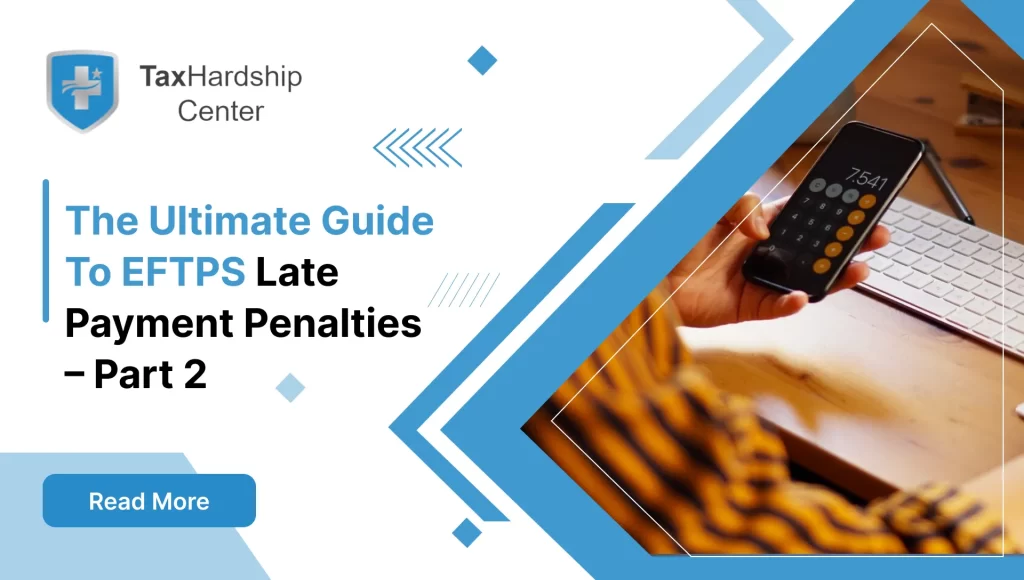Filing taxes can often be complex, especially when corrections are needed. The IRS provides a solution for such adjustments through Form 1040X, the Amended U.S. Individual Income Tax Return. In this blog post, we’ll explore what the form is used for, who can file it, and the benefits of doing so.
What Is Form 1040-X, Amended U.S. Individual Income Tax Return?
Form 1040-X is a critical IRS form designed for taxpayers who must amend inaccuracies or omissions in their previously filed income tax returns. Whether it’s a discrepancy in individual income, tax credits, deductions, or filing status, an amended tax return allows these corrections to be formally recognized by the IRS. It ensures that your tax obligations reflect your true financial activity over the tax year.
Maximize Your Refund with Ease: Trust Tax Hardship Center
Let Tax Hardship Center take the reins on your amended tax returns. Our expert team guarantees a hassle-free Form 1040-X filing and ensures you claim every credit and deduction you deserve. Say goodbye to errors and hello to potential savings with our meticulous review process. Choose us for a smooth amendment experience and watch us turn tax troubles into triumphs—all while you relax, knowing your finances are in expert hands.
Who Can File Form 1040-X?
Any taxpayer who has filed a federal income tax return and subsequently identified errors or overlooked opportunities for tax savings can file an amended return using Form 1040-X. This includes individuals who have either underreported or overreported their income, missed claiming legitimate tax deductions or credits, or need to update their filing status. Utilizing Form 1040-X allows federal tax filers to rectify these mistakes and improve their tax liability.
What Is a 1040-X Form Used for?
The IRS Form 1040-X, the Amended U.S. Individual Income Tax Return, plays a crucial role in the tax filing process for individuals seeking to make post-filing alterations to their federal tax returns. There are several scenarios where taxpayers may need to utilize this form.
Correcting Errors
Taxpayers who have identified errors in their previously filed Form 1040, Form 1040-A, or Form 1040-EZ can use Form 1040-X to correct those mistakes. Common errors requiring an amendment include incorrect income reporting, a missed deduction or credit, or an incorrect filing status.
Reporting Additional Income
Sometimes, after filing your tax return, you may receive additional tax documentation, like a revised W-2 or 1099 form, which reports income not included on your original tax return. In such cases, Form 1040-X updates your income information and potentially adjusts your tax liability.
Changing Tax Deductions or Credits
If you initially overlooked a deduction or tax credit you were eligible for, you could file Form 1040-X to claim these benefits retrospectively. Conversely, if you claimed deductions or credits you were not entitled to, you must amend your return to correct this overstatement.
Modifying Filing Status
In certain circumstances, you might need to change your filing status – for example, if you mistakenly filed as a single taxpayer when you qualify for a more beneficial status like head of household. The 1040-X form facilitates such changes.
Carrying Back a Net Operating Loss
Business owners who experience a net operating loss (NOL) may carry back that loss to a prior tax year to offset income and secure a refund. To apply this change, an amended return via Form 1040-X is necessary.
In any case, the goal of the 1040-X form is to reconcile your tax return with accurate financial information, ensuring that you pay your fair share of taxes – not more, not less – according to the latest available data.
What Are the Benefits of Filing Form 1040-X?
Correcting a tax return may seem daunting, but filing an amended return using Form 1040-X can provide several advantages that impact your financial health and peace of mind. Whether it’s an oversight or new information that prompts the change, understanding the benefits of filing an amended return can help you confidently navigate the decision.
Claiming Additional Refunds
If an error on your original return caused you to miss out on a refund you were rightfully owed, filing an amended return can rectify this. You might have overlooked a credit or deduction or didn’t report a tax break you now realize you qualify for. An amended return allows you to claim these benefits after the fact. If the IRS processes your amendment and agrees with the corrections, you could receive an additional refund.
Reducing Tax Liability
Filing Form 1040-X can also reduce tax liability if the original return included errors that resulted in you paying more tax than necessary. This may happen if you overestimated your income, misreported taxable events, or did not take advantage of the full scope of deductions or credits available.
Improving Accuracy and Compliance
Accuracy in tax reporting is a compliance issue and an ethical responsibility. By amending your return, you are taking proactive steps to ensure that all information you submit to the IRS is as accurate and complete as possible. This reflects good faith, showing you intend to meet all your tax obligations.
Avoiding Penalties and Interest
If your original return understated your tax liability, you risk incurring penalties and interest from when the tax was due. You may mitigate these penalties and interest charges by catching and correcting these errors yourself through an amended return. The sooner you file the amended return, the lower these potential charges are likely to be as they accumulate over time.
Claiming Missed Credits and Deductions
It’s not uncommon for taxpayers to miss potential credits and deductions when filing their initial returns. If you didn’t claim eligible education credits, for instance, or you should have included charitable donations, Form 1040-X is your opportunity to correct the record and lower your tax bill.
Do You Have to File Form 1040-X With Form 1040?
The Form 1040-X is intended to be utilized separately from your original tax return. Instead, it is designed as a follow-up document for corrections after the IRS has processed your initial return. Once the IRS has accepted and processed your original tax return, they consider submitting your tax statement for the year.
If, after this point, you discover an error or receive updated information that significantly alters the figures reported on your original tax return, Form 1040-X becomes applicable. You should prepare this amended return carefully, ensuring the new data is accurate, and include any additional necessary documentation to substantiate the changes.
The amended tax return process exists to accommodate changes and corrections, reflecting the reality that taxpayers’ financial situations can evolve or become more evident after the initial filing deadline. However, be mindful that amended returns are subject to IRS scrutiny and should be filed only when necessary and with complete and accurate revisions.
How to File Form 1040-X?
Filing an amended tax return using Form 1040-X can be necessary when you must correct or update information on a tax return from a previous year. The process is systematic, and attention to detail is paramount to ensure your amendments are communicated to the IRS. Here’s a step-by-step guide to help you through amending your tax returns with Form 1040-X.
Step 1: Obtain the Correct Form
Start by downloading the most recent version of Form 1040-X from the official IRS website. It’s imperative to use the latest form to avoid any processing delays that can arise from submitting outdated versions.
Step 2: Gather Your Original Tax Return and Supporting Documents
Have your original tax return and any relevant documentation on hand. This includes your original Form 1040 and any forms, schedules, or receipts about your changes. These documents will provide the baseline figures you’ll need to report and will support the adjustments you’re making.
Step 3: Fill Out Form 1040-X Accurately
On Form 1040-X, you’ll notice three columns:
- Column A is where you’ll input the amounts from the original tax return.
- Column B will show the difference between the original figures and the corrected amounts (increases or decreases).
- Column C will display the corrected amounts.
Make sure to fill in each column carefully. Incorrect or incomplete forms can result in processing delays or additional correspondence from the IRS.
Step 4: Provide a Detailed Explanation of the Changes
You must also include a clear and concise explanation for each amendment. This part is essential, as it informs the IRS why you submitted an amended return. Your explanation should align with the numerical changes laid out in Columns A, B, and C.
Step 5: Attach Amended Forms and Schedules
If your amendments require updates to other forms and schedules, such as Schedule A for itemized deductions or Schedule C for business income, you must complete these forms and attach them to your Form 1040-X.
Step 6: Double-Check Your Information
Review your Form 1040-X and accompanying documents one more time for accuracy. This helps prevent any unnecessary mistakes that could prolong the process.
Step 7: Mail the Amended Return
E-filing is not an option for Form 1040-X, so you must send it via postal mail. Make sure to send it to your state’s correct IRS processing center. The appropriate mailing address can be found in the instructions for Form 1040-X or on the IRS website. You should send your documentation via a method that includes tracking or delivery confirmation.
Step 8: Retain Copies and Track the Filing
Always keep copies of your Form 1040-X and all supporting documentation for your records. After mailing, you can track the status of your amended return by using the Where’s My Amended Return? Online tool provided by the IRS.
Where Do You Send Form 1040-X?
When you plan to submit Form 1040-X to amend a previously filed tax return, sending it to the correct address is crucial to ensure timely and accurate processing by the Internal Revenue Service (IRS). The destination for your amended return depends on several factors, particularly your residence and whether you are including a payment with your submission. The IRS maintains separate addresses for different regions and circumstances, so confirming the correct address for your situation is a crucial step in the amendment process.
To find the most up-to-date mailing address:
1. Visit the IRS Website: The IRS regularly updates mailing addresses on its official website. You can find the information under the instructions for Form 1040-X or within their Where to File pages.
2. Review the Form 1040-X Instructions: The instructions accompanying Form 1040-X will have a list of addresses divided by state and filing type. This list will indicate where to send your form if you owe additional tax with the return and a separate address if you expect a refund or have no payment to send.
3. Check for Special Circumstances: If your tax situation involves unusual circumstances—for example if you’re filing Form 1040-X because of a notice you received from the IRS—additional guidance will be provided on where to mail your amended return.
What Are the Total Costs Associated with Filing Form 1040-X?
Filing an amended return with Form 1040-X involves several potential costs, which can vary greatly depending on the complexity of the amendments and how you choose to proceed with the filing.
Here are some everyday expenses you might incur:
1. Postage and Shipping Costs: Since Form 1040-X cannot be e-filed and must be mailed, you will need to cover the postage cost. If you send your documents via certified mail or with a return receipt requested for added security, this will increase the mailing cost.
2. Interest and Penalties: If you are amending your return because you owe additional tax, the IRS may charge interest on the amount due. You might also be penalized if the original mistake led to underpaying tax by the due date.
3. Possible Refund Reduction: While not a direct out-of-pocket cost, if your amendment results in a lower refund than you originally received, this could be considered an indirect cost of filing Form 1040-X.
Conclusion:
Understanding Form 1040-X, the Amended U.S. Individual Income Tax Return, is crucial for taxpayers who need to correct errors or update their previously filed tax returns. This form provides a systematic process for rectifying mistakes, claiming missed deductions or credits, and ensuring accurate financial reporting to the IRS. By familiarizing yourself with the purpose, eligibility criteria, benefits, and filing process of Form 1040-X, you can navigate tax-related challenges with confidence and peace of mind.
Why Tax Hardship Center?
1. Hassle-Free Assistance:
Say goodbye to sleepless nights and endless tax-related stress. At the Tax Hardship Center, we believe in simplifying the complex. Our team of experts is dedicated to guiding you through every step of the process, ensuring that your tax concerns are met with precision and care.
2. 14-Day Money Back Guarantee:
We’re so confident in our ability to ease your tax worries that we offer a 14-day money-back guarantee. If, for any reason, you’re not satisfied with our service, we’ll gladly refund your investment. Your peace of mind is our top priority!
3. Free Consultation:
Are you curious about how we can transform your tax experience? Book a free consultation now! Our team will assess your situation, answer your questions, and provide free insights tailored to your needs.
4. Nationwide Coverage:
No matter which corner of the United States you call home, the Tax Hardship Center covers you. We proudly serve all 50 states, bringing our expertise to your doorstep. Wherever you are, our commitment to excellence follows.
FAQs:
1. What is Form 1040-X, and who can file it?
Form 1040-X, the Amended U.S. Individual Income Tax Return, corrects errors or updates previously filed tax returns. Any taxpayer who has filed a federal income tax return and subsequently identified errors or overlooked opportunities for tax savings can file an amended return using Form 1040-X.
2. What are the benefits of filing Form 1040-X?
Filing Form 1040-X allows taxpayers to claim additional refunds, reduce tax liability, improve accuracy and compliance with tax laws, and avoid penalties and interest charges. It also enables taxpayers to claim missed credits and deductions, ensuring they pay their fair share of taxes based on accurate financial information.
3. Do you have to file Form 1040-X with Form 1040?
No, Form 1040-X will be utilized separately from your original tax return. It is a follow-up document for corrections after the IRS has processed your initial return. Once the IRS has accepted and processed your original tax return, they consider submitting your tax statement for the year.
4. How do you file Form 1040-X?
Filing an amended tax return using Form 1040-X involves several steps, including obtaining the correct form, gathering the original tax return and supporting documents, accurately filling out Form 1040-X, providing a detailed explanation of the changes, attaching amended forms and schedules if necessary, double-checking all information, mailing the amended return to the correct IRS processing center, retaining copies, and tracking the filing.
5. Where do you send Form 1040-X?
The destination for your amended return depends on several factors, particularly your residence and whether you are including a payment with your submission. You can find the most up-to-date mailing address on the IRS website, in the instructions for Form 1040-X, or by reviewing the instructions for Form 1040-X.








